Toyota Mirai
| Toyota Mirai (series JPD10) | |
|---|---|
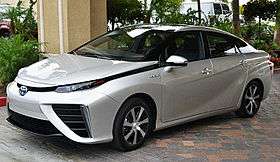 Toyota Mirai | |
| Overview | |
| Manufacturer | Toyota |
| Production | 2014–present |
| Assembly | Japan: Toyota, Aichi (Motomachi plant)[1] |
| Body and chassis | |
| Class | Mid-size luxury car[2] |
| Body style | 4-door sedan |
| Layout | FF |
| Related |
Toyota FCV concept Toyota Prius |
| Powertrain | |
| Electric motor | Fuel cell-powered 113 kW (152 hp) 335 N⋅m (247 lbf⋅ft)[3] |
| Transmission | 1-speed |
| Battery | 1.6 kWh Nickel-metal hydride[4][5] |
| Range | 502 km (312 mi) (EPA)[6] |
| Dimensions | |
| Wheelbase | 2,780 mm (109.4 in)[3] |
| Length | 4,890 mm (192.5 in)[3] |
| Width | 1,815 mm (71.5 in)[3] |
| Height | 1,535 mm (60.4 in)[3] |
| Curb weight | 1,850 kg (4,078.6 lb)[3] |
The Toyota Mirai (from mirai (未来), Japanese for "future") is a mid-size hydrogen fuel cell car manufactured by Toyota, one of the first such sedan-like vehicles to be sold commercially.[7][8] The Mirai was unveiled at the November 2014 Los Angeles Auto Show.[9] As of December 2017, global sales totaled 5,300 Mirais. The top selling markets were the U.S. with 2,900 units, Japan with 2,100 and Europe with 200.[10]
Under the United States Environmental Protection Agency (EPA) cycle, the 2016 model year Mirai has a total range of 502 km (312 mi) on a full tank, with a combined city/highway fuel economy rating of 66 mpg‑US (3.6 L/100 km; 79 mpg‑imp) equivalent (MPG-equivalent), making the Mirai the most fuel efficient hydrogen fuel cell vehicle rated by the EPA, and the one with the largest range.[6]
Sales in Japan began on 15 December 2014 at a price of ¥6.7 million (~US$57,400) at Toyota Store and Toyopet Store locations. The Japanese government plans to support the commercialization of fuel-cell vehicles with a subsidy of ¥2 million (~US$19,600).[11] Retail sales in the U.S. began in August 2015 at a price of US$57,500 before any government incentives. Deliveries to retail customers began in California in October 2015.[12] Toyota scheduled to release the Mirai in the Northeastern States in the first half of 2016.[13] As of June 2016, the Mirai is available for retail sales in the UK, Denmark, Germany, Belgium, and Norway.[14] Pricing in Germany starts at €60,000 (~US$75,140) plus VAT (€78,540).[15]
History
FCV concept
The Mirai is based on the Toyota FCV-R (Fuel Cell Vehicle) concept car, which was unveiled at the 2011 Tokyo Motor Show[16][17] and the Toyota FCV (Fuel Cell Vehicle) concept car, which was unveiled at the 2013 Tokyo Motor Show.[18] The unveiled FCV concept was a bright blue sedan shaped like a drop of water "to emphasize that water is the only substance that hydrogen-powered cars emit from their tailpipes." The FCV has a large grille and other openings to allow cooling air and oxygen intake for use by the fuel cell. According to Toyota, the FCV concept is close in appearance to the expected production version of the car.[19] The FCV size is similar to the Toyota Camry.[20] The FCV range is expected to be approximately 700 km (430 mi) under Japan's JC08 test cycle.[21]

According to Toyota, the FCV features a fuel cell system with an output power density of 3.0 kW/L, which is twice as high as that of its previous fuel cell concept, the Toyota FCHV-adv, delivering an output power of more than 100 kW, despite significant unit downsizing. The FCV uses Toyota's proprietary, small, light-weight fuel cell stack and two 70 MPa high-pressure hydrogen tanks placed beneath the specially designed body. The Toyota FCV concept can accommodate up to four occupants. For the full-scale market launch in 2015, the cost of the fuel cell system is expected to be 95% lower than that of the 2008 Toyota FCHV-adv.[22]
The FCV concept also uses portions of Toyota's Hybrid Synergy Drive technology including the electric motor, power control unit and other parts and components from its hybrid vehicles to improve reliability and minimize cost.[22] The hybrid technology is also used to work together with the fuel cell. At low speeds such as city driving, the FCV runs just like any all-electric car by using the energy stored in its battery, which is charged through regenerative braking. At higher speeds, the hydrogen fuel cell alone powers the electric motor. When more power is needed, for example during sudden acceleration, the battery supports the fuel cell system as both work together to provide propulsion.[23]
In June 2014 Toyota showcased an FCV with an exterior design close to production, and announced details about pricing in Japan and set a domestic market launch before April 2015 with initial sales limited to regions where hydrogen refueling infrastructure is being developed.[24]
Timeline
- 1992: Toyota starts development of FCV technology.[21]
- 1996: The EVS13, an FCV with a metal hydride hydrogen tank, takes part in a parade in Osaka.[21]
- 2001: Toyota shows the FCHV-4, FCHV-5, and Daihatsu MOVE FCV-K-II fuel-cell cars at the Tokyo Motor Show.[25]
- 2002: The Highlander-based FCHV is available for limited sales in the U.S. and Japan. The fuel-cell stack outputs 90 kW. The cruising range is 300 km (185 miles). Two FCHVs are delivered to the Irvine and Davis campuses of University of California, four go to government departments in Japan.[26]
- 2003: Toyota and Daihatsu begin road testing of the MOVE FCV-K-II, a fuel-cell Kei car.[27]
- 2005: FCHV receives type certification in Japan.[21]
- 2008: The FCHV-adv has increased range of 830 km (515 miles) for the 10-15 test cycle and better cold start capabilities.[21]
- 2009: U.S. government drops funding for hydrogen fuel-cell cars.[28][29]
- 2010: A Toyota/Hino FCHV Bus services daily commercial routes between Tokyo’s Haneda Airport and the city center.[30][31]
- 2011: Satoshi Ogiso, deputy chief officer Product Planning Group, declares all technical problems as solved, says “the only remaining real issue that stands in the way of fuel-cell electric vehicles is mass production cost.”[32]
- 2011: Toyota shows an FCV concept vehicle, dubbed "FCV-R," at the Tokyo Motor Show.[16][17]
- 2012: Toyota Chairman Takeshi Uchiyamada says: “The current capabilities of electric vehicles do not meet society’s needs, whether it may be the distance the cars can run, or the costs, or how it takes a long time to charge.”[33]
- 2013: Reporters drive test mules of the fuel cell vehicle. Toyota demonstrates that fueling takes less than three minutes.[34]
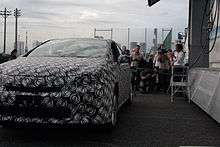 Toyota fuel cell test mule fueling hydrogen in Tokyo.
Toyota fuel cell test mule fueling hydrogen in Tokyo. - 2013: Toyota shows FCV sedan at Tokyo Motor Show.[18][35]
- June 2014: Toyota shows close-to-production FCV to the press. Announces early 2015 availability in Japan at around ¥7,000,000.[36]
- November 2014: Toyota launches a press release and photos detailing the production version of the fuel cell vehicle. Also announced is the official model name of Mirai which means "future".[37]
- April 2015: The Mirai was the first hydrogen fuel cell vehicle to pace a NASCAR race at the Toyota Owners 400 at Richmond, US.
- June 2015: The Mirai was the pace car at the Toyota/Save Mart 350 at Sonoma, US.
- October 21, 2015: Start sale and deliver in California, the same day to which the fusion-powered flying car in the film Back to the Future Part II time-travelled.[38]
- August 2018: A Mirai was refilled in Australia with hydrogen separated from ammonia using a membrane technology.[39]
Testing
Toyota began fuel cell development in Japan in the early 1990s and has developed a series of fuel cell vehicles, subjecting them to more than 1,600,000 km (1,000,000 miles) of road testing.
Since 2012, fuel cell test vehicles have logged thousands of miles on North American roads. This includes hot testing in Death Valley, cold testing in Yellowknife, Canada, steep grade hill climbs in San Francisco and high altitude trips in Colorado. The Toyota-designed carbon fiber hydrogen tanks have also undergone extreme testing to ensure their strength and durability in a crash.[40]
Between September 2015 and February 2016, one Mirai was driven 100,000 km (62,000 miles) in 107 days on different roads in Hamburg, using just over one tonne of hydrogen.[41]
Toyota started testing two Mirai fuel cells in an electric Class 8 semi-trailer truck in the Port of Los Angeles in 2017 as part of Project Portal.[42]
Specifications

The Mirai uses the Toyota Fuel Cell System (TFCS), which features both fuel cell technology and hybrid technology, and includes proprietary Toyota-developed components including the fuel cell (FC) stack, FC boost converter, and high-pressure hydrogen tanks. The TFCS is more energy-efficient than internal combustion engines and emits no CO2 at the point of operation or substances of concern (SOCs) when driven. The system accelerates Mirai from 0 to 97 km/h (0 to 60 mph) in 9.0 seconds and delivers a passing time of 3 seconds from 40 to 64 km/h (25 to 40 mph). The Mirai refueling takes between 3 and 5 minutes, and Toyota expected a total range of 480 km (300 miles) on a full tank.[40] The Mirai has a button labeled H2O that opens a gate at the rear, dumping the water vapor that forms from the hydrogen-oxygen reaction in the fuel cell.[4] The exhaust H2O or water volume is 240 mL per 4 km running.[43]
Fuel economy and range
Under the United States Environmental Protection Agency (EPA) cycle, the 2016 model year Mirai has a range of 502 km (312 mi) on a full tank, with a combined city/highway fuel economy rating of 66 mpg‑US (3.6 L/100 km; 79 mpg‑imp) equivalent (MPG-equivalent).[6] The following table compares the Mirai with other FCVs available for leasing in California as of November 2016.[6]
| Comparison of fuel economy expressed in MPGe for hydrogen fuel cell vehicles available for leasing in California and rated by the U.S. Environmental Protection Agency as of August 2015[6] | |||||||
|---|---|---|---|---|---|---|---|
| Vehicle | Model year | Combined fuel economy | City fuel economy | Highway fuel economy | Range | Annual fuel cost | |
| Honda Clarity Fuel Cell | 2017 | 67 mpg-e | 68 mpg-e | 66 mpg-e | 366 mi (589 km) | US$1,250 | |
| Toyota Mirai | 2016-17 | 66 mpg-e | 66 mpg-e | 66 mpg-e | 312 mi (502 km) | US$1,250 | |
| Honda FCX Clarity | 2014 | 59 mpg-e | 58 mpg-e | 60 mpg-e | 231 mi (372 km) | NA | |
| Hyundai Tucson Fuel Cell | 2017 | 49 mpg-e | 48 mpg-e | 50 mpg-e | 265 mi (426 km) | US$1,700 | |
| Notes: One kg of hydrogen is roughly equivalent to one U.S. gallon of gasoline. | |||||||
Fuel cell stack

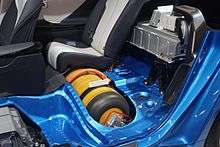
The new Toyota FC Stack achieves a maximum output of 114 kW (153 hp). Electricity generation efficiency has been enhanced through the use of 3D fine mesh flow channels. These channels—a world first, according to Toyota—are arranged in a fine three-dimensional lattice structure and enhance the dispersion of air (oxygen), thereby enabling uniform generation of electricity on cell surfaces. This, in turn, provides a compact size and a high level of performance, including the stack’s world-leading power output density of 3.1 kW/L (2.2 times higher than that of the previous Toyota FCHV-adv limited-lease model), or 2.0 kW/kg. Each stack comprises 370 (single-line stacking) cells, with a cell thickness of 1.34 mm and weight of 102 g. The compact Mirai FC stack generates about 160 times more power than the residential fuel cells on sale in Japan.[40] The Mirai has a new compact (13-liter), high-efficiency, high-capacity converter developed to boost voltage generated in the Toyota FC Stack to 650 volts.[40]
High-pressure hydrogen tanks
The Mirai has two hydrogen tanks with a three-layer structure made of carbon fiber-reinforced plastic consisting of nylon 6 from Ube Industries[44] and other materials. The tanks store hydrogen at 70 MPa (10,000 psi). The tanks have a combined weight 87.5 kg (193 lb).[3][40] and 5 kg capacity.
Electric traction motor and battery
Toyota's latest generation hybrid components were used extensively in the fuel cell powertrain, including the electric motor, power control and main battery. The electric traction motor delivers 113 kilowatts (152 hp) and 335 N⋅m (247 lbf⋅ft) of torque. The Mirai has a 245V (1.6 kWh) sealed nickel-metal hydride (NiMH) traction rechargeable battery pack, similar to the one used in the Toyota Camry hybrid.[4][5][40]
Safety

At Toyota’s Higashi-Fuji Technical Center, the Mirai has been subjected to extensive crash testing to evaluate a design specifically intended to address frontal, side and rear impacts and to provide excellent protection of vehicle occupants. A high level of collision safety has also been achieved to help protect the fuel cell stack and high-pressure tanks against body deformation. The high pressure hydrogen tanks have excellent hydrogen permeation prevention performance, strength, and durability. Hydrogen sensors provide warnings and can shut off tank main stop valves. The hydrogen tanks and other hydrogen-related parts are located outside the cabin to ensure that if hydrogen leaks, it will dissipate easily. The vehicle structure is enhanced with carbon-fiber-reinforced polymers from Toray[45] and designed to disperse and absorb impact energy across multiple parts to ensure a high-impact safety performance that protects the Toyota FC Stack and high-pressure hydrogen tanks during frontal, side or rear impacts.[40]
Infrastructure
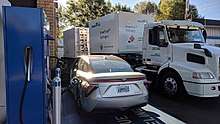

As of January 2013, Japan had ten demonstration hydrogen fueling stations.[46] Toyota operated three of these stations.[47] To support commercialization of hydrogen fuel-cell vehicles by Toyota and other manufacturers, the Japanese government announced a goal to build approximately 100 hydrogen fueling stations by March 2016 in Japanese cities where the vehicles were to be launched initially.[48] By May 2016, there were approximately 80 hydrogen fueling stations in Japan.[49]
California had ten hydrogen fueling stations in 2015, and the government provided about $47 million for 28 additional stations there.[20] As of December, 2017, there are 19 True Zero hydrogen stations[50] and 33 total hydrogen stations operating in California.[51]
Production
Production of the fuel cell parts began in the Toyota Boshoku factory in November 2014.[52]
Markets and sales
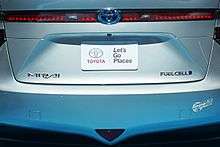
| Calendar Year | US |
|---|---|
| 2015 | 72 [53] |
| 2016 | 1,034 [53] |
| 2017 | 1,838 [53] |
In January 2015 it was announced that production of the Mirai fuel cell vehicle would increase from 700 units in 2015 to approximately 2,000 in 2016 and 3,000 in 2017.[54] As of December 2017, global sales totaled 5,300 Mirais. The top selling markets were the U.S. with 2,900 units, Japan with 2,100 and Europe with 200.[10]
Japan
Sales in Japan began on December 15, 2014.[55] Pricing starts at ¥6,700,000 (~US$57,400) before taxes and a government incentive of ¥2,000,000 (~US$19,600).[11] Initially sales are limited to government and corporate customers. As of December 2014, domestic orders had already reached over 400 Mirais, surpassing Japan's first-year sales target, and as a result, there is a waiting list of more than a year.[55] The dimensions of the Mirai place it in a higher tax bracket outlined in the Japanese Governments dimension regulations, and the weight of the vehicle is also taxed annually during the annual road tax obligation.
The Japanese government also provides a subsidy of 50% of the installation costs, with ¥7,200,000,000 (~US$61.7 million) allocated for fiscal year 2014.[56] A hydrogen station in Japan costs ¥280,000,000 (~US$2.4 million) which is about ¥150,000,000 (~US$1.29 million) more than in Europe which allows more generic materials.
Toyota delivered the first market placed Mirai to the Prime Minister's Official Residence and announced it got 1,500 orders in Japan in one month after sales began on December 15, 2014 against a sales target of 400 for 12 months.[57][58] By mid-February 2017 about 1,500 Mirais have been sold in Japan,[59] and a total of about 2,100 at the end of 2017.[10]
United States

The first 57 units were delivered to retail customers in California in October and November 2015.[12] Toyota hoped to release the Mirai in the five Northeastern States in the first half of 2016 as hydrogen fueling infrastructure is built in the Boston and New York City regions. Toyota will provide free hydrogen fueling for the first three years to initial buyers of the Mirai, just as Hyundai does for lessees of its Hyundai Tucson-ix35 Fuel Cell in California.[13][60] Toyota planned for cumulative sales of 3,000 Mirais in the U.S. by the end of 2017.[13]
In the American market the 2016 model year Toyota Mirai started at US$57,500 before any government incentives, and a leasing option for 36 months is available with a $3,649 down payment and a lease rate of $499 per month.[13][60][61] Several states have established incentives and tax exemptions for fuel cell vehicles.[62][63] As a zero-emission vehicle (ZEV), the Mirai is eligible for a purchase rebate in California of US$5,000 through the Clean Vehicle Rebate Project.[63] The federal tax credit for fuel cell vehicles originally expired on 31 December 2014,[60][64] but was retroactively extended through 31 December 2016.[64] By September 2016, Toyota had reduced down-payment from US$3,649 to US$2,499 and leasing price to US$349/month with several benefits,[65] and sold 710 Mirais.[66]
As of December 2017, U.S. sales totaled about 2,900 Mirais.[10] Sales in California pass the 3,000 unit mark in January 2018, where there are 31 retail hydrogen stations in operation, with an additional 12 stations projected to open in the state in 2018.[67] As of January 2018, Mirai sales represent more than 80% of all hydrogen fuel cell vehicles on the road in the United States.[67]
Canada
In January 2018, Toyota Canada announced that the Mirai for the Canadian market would first become available in Quebec, in line with the provincial government's zero-emission vehicle standard adopted the previous month.[68] Previously, a fleet of 50 Mirai vehicles had been internally tested by the Quebec government under the direction of Quebec's Minister of Natural Resources, Pierre Morneau. The first[69] public demonstrations for the vehicle took place at the January 2018 Montreal International Auto Show.[70] Toyota is partnering with, among other agencies, Quebec's Ministry of Energy and Hydro-Québec, to introduce hydrogen fueling infrastructure in the province.[71]
Europe
The market launch in Europe was slated for September 2015.[13] The UK, Germany and Denmark were the first European countries where the Mirai was released, to be followed by additional markets in 2017.[15] In Germany, pricing starts at €60,000 (~US$75,140) plus VAT.[15] As of June 2016, the Mirai is available for retail sales in the UK, Denmark, Germany, Belgium, and Norway.[14] About 200 Mirais had been sold by the end of 2017.[10]
Former European Parliament President Pat Cox estimated that Toyota would initially lose between €50,000 to €100,000 (US$60,000 to US$133,000 at 2014 exchange rates) on each Mirai sold in 2015.[72]
Recognition
The Toyota Mirai won the 2016 World Green Car of the Year Award, announced at the 2016 New York International Auto Show.[73]
Marketing

In 2015, Toyota released a series of video commercials for the Mirai entitled Fueled By..., showing how hydrogen to power fuel cells like the ones that Mirais use could come from various unexpected sources.[74] The last one, entitled Fueled by the Future, featured Michael J. Fox, Christopher Lloyd and YouTube science personality Go Tech Yourself, doubled as a tribute to the Back to the Future franchise and illustrated how the idea of converting trash into fuel (which had been introduced with the "Mr. Fusion" reactor that Dr. Emmett Brown (Lloyd) had brought back from the future at the end of the first film) had become reality. The commercial was released on October 21 - the same date in 2015 that Marty McFly (Fox), Jennifer Parker (Claudia Wells/Elizabeth Shue) and Brown traveled to in Back to the Future Part II.
Recalls
On 15 February 2017 Toyota recalled all of the roughly 2,800 zero-emission Mirai cars on the road due to problems with the output voltage generated by their fuel cell system. According to Toyota, under unique driving conditions, such as if the accelerator pedal is depressed to the wide open throttle position after driving on a long descent while using cruise control, there was a possibility the output voltage generated by the fuel cell boost converter could exceed the maximum voltage. Toyota dealers announced they will update the fuel cell system software at no cost to the customer, claiming the process will take about half an hour.[75][76]
See also
References
- ↑ "Japanese Production Sites". Toyota. 2015-03-06. Archived from the original on 2015-03-18.
- ↑ "【トヨタの高級車価格ランキング】燃費やスペックも紹介!最も高いのは?" [【Toyota's luxury car price ranking】 Introduction of fuel consumption and specifications! What is the highest?]. Moby (in Japanese). Japan. 2017-05-25. Retrieved 2018-06-12.
- 1 2 3 4 5 6 7 Mark Kane (2014-11-18). "Toyota Mirai Fuel Cell Sedan Priced At $57,500 – Specs, Videos". InsideEVs.com. Retrieved 2014-11-19.
- 1 2 3 Wayne Cunningham (2014-11-19). "Toyota Mirai: The 300-mile zero-emission vehicle". CNET. Retrieved 2014-11-21. The Mirai has a 245-volt nickel-metal hydride battery pack, similar to that in the Camry Hybrid.
- 1 2 Josh Pihl (January 2014). "Table 33. Batteries for Selected Hybrid-Electric Vehicles, Model Years 2013-2014". Oak Ridge National Laboratory. Archived from the original on 2014-11-29. Retrieved 2014-11-21. The Toyota Camry Hybrid uses a 1.6 kWh NiMH battery.
- 1 2 3 4 5 United States Environmental Protection Agency and U.S. Department of Energy (November 2016). "Compare Fuel Cell Vehicles". fueleconomy.gov. Retrieved 2016-11-24. One kg of hydrogen is roughly equivalent to one U.S. gallon of gasoline.
- ↑ "Toyota Unveils 2015 Fuel Cell Sedan, Will Retail in Japan For Around ¥7 Million". transportevolved.com. 2014-06-25. Retrieved 2014-06-26.
- ↑ "What is a Fuel Cell Vehicle?". Retrieved 2014-08-06.
- ↑ Millikin, Mike (2014-11-17). "Akio Toyoda announces name of Toyota's new fuel cell sedan in web video: Mirai". Green Car Congress. Retrieved 2014-11-17.
- 1 2 3 4 5 "Toyota sells 1.52 million electrified vehicles in 2017, three years ahead of 2020 target" (Press release). Toyota City, Japan: Toyota. 2018-02-02. Retrieved 2018-02-02.
- 1 2 Ken Moritsugu (2014-11-18). "oyota to start sales of fuel cell car next month". Associated Press. Fox News Chicago. Archived from the original on 2014-11-29. Retrieved 2014-11-19.
- 1 2 3 John Voelcker (2015-12-14). "Portable Hydrogen Fuelers Go To Six Toyota Mirai Dealers As Stations Lag". Green Car Reports. Retrieved 2015-12-18.
- 1 2 3 4 5 John Voelcker (2014-11-18). "2016 Toyota Mirai Priced At $57,500, With $499 Monthly Lease". Green Car Reports. Retrieved 2014-11-19.
- 1 2 "First Toyota Mirai delivered to Uno-X Hydrogen in Norway, with plans to harness the power of renewables for true zero-emission" (Press release). Brussels: Toyota Europe. 2016-06-20. Retrieved 2016-06-24.
- 1 2 3 "Toyota Ushers In The Future With Launch Of 'Mirai' Fuel Cell Sedan" (Press release). Toyota City, Japan: Toyota Europe. 2014-11-01. Archived from the original on 2014-12-05. Retrieved 2014-11-18.
- 1 2 "Toyota FCV-R concept brings fuel cell cars closer to reality, aiming for 2015 launch". Retrieved 2014-06-27.
- 1 2 "Tokyo motor show 2011: Toyota FCV-R". 30 Nov 2011. Retrieved 2014-06-27.
- 1 2 "Toyota Shows Off Fuel-Cell Automobile". 2013-11-20. Retrieved 2014-06-27.
- ↑ Eric Pfanner (2013-11-20). "Toyota Shows Off Fuel-Cell Automobile". The New York Times. Retrieved 2014-11-18.
- 1 2 "Toyota to Offer $69,000 Car After Musk Pans 'Fool Cells'". 2014-06-25. Retrieved 2014-06-27.
- 1 2 3 4 5 "Toyota's Approach to Fuel Cell Vehicles". 2014-06-25. Archived from the original on 2014-06-29. Retrieved 2014-06-27.
- 1 2 Mike Millikin (2014-03-11). "Toyota continues to prepare the market for fuel cell vehicle in 2015". Green Car Congress. Retrieved 2014-11-18.
- ↑ Toyota Europe. "Fuel Cell Technology - Another step towards sustainable mobility". Toyota Europe. Retrieved 2014-11-18.
- ↑ Mike Millikin (2014-06-25). "Toyota to launch its fuel cell vehicle in Japan before April 2015, priced around $68,700; reveals exterior". Green Car Congress. Retrieved 2014-11-17.
- ↑ "Toyota and Daihatsu to Present "New Dream-filled Mobility"". 2001-10-17. Retrieved 2014-06-27.
- ↑ "Fuel-Cell-Hybrid Vehicle (FCHV) E. Peled, Tel Aviv University" (PDF). February 2009. Retrieved 2014-06-27.
- ↑ "It's the world's smallest". Retrieved 2014-06-27.
- ↑ "Government Gives Up on Hydrogen Fuel-Cell Cars". May 11, 2009. Retrieved 2014-06-27.
- ↑ "GM, Toyota Fuel-Cell Plans Clash With U.S. Battery Car Push". 2009-10-09. Retrieved 2014-06-27.
- ↑ "Trial servicing Fuel Cell Hybrid Vehicle (FCHV-BUS)". Retrieved 2014-06-27.
- ↑ "TMC, Hino to Provide Fuel-cell Bus for Tokyo Airport Routes". Dec 7, 2010. Retrieved 2014-06-27.
- ↑ "Toyota's Prius Chief Engineer Reveals the Future of the Automobile. Part Two: What Will We Drive In 10 Years?". 2011-11-14. Retrieved 2014-06-27.
- ↑ "Toyota Launches New EV, But Doesn't Really Mean It. A Report From Green Hell". 2012-09-24. Retrieved 2014-06-27.
- ↑ "Daily Kanban drives Toyota's 2015 fuel cell car, talks to its father". 2013-10-10. Retrieved 2014-06-27.
- ↑ "Live pictures of Toyota's hydrogen-powered fuel-cell car". 2013-11-20. Retrieved 2014-06-27.
- ↑ "Toyota launches fuel cell car in earnest, and with a few puns". June 25, 2014. Retrieved 2014-06-27.
- ↑ Michael Szostech. "2016 Toyota Mirai Fuel Cell Sedan Product Information". My Toyota Mirai. My Electric Car Forums. Retrieved 2014-11-20.
- ↑ "Toyota takes car-tech "Back To the Future"—again". Fortune. 2015-10-21. Retrieved 2015-10-22.
- ↑ Mealey, Rachel (2018-08-08). "Automotive hydrogen membranes-huge breakthrough for cars". Australia: ABC. Retrieved 2018-08-30.
- 1 2 3 4 5 6 7 Mike Millikin (2014-11-18). "Toyota FCV Mirai launches in LA; initial TFCS specs; $57,500 or $499 lease; leaning on Prius analogy". Green Car Congress. Retrieved 2014-11-23.
- ↑ Cornaert, Jean Jacques (2016-03-13). "Mirai Marathon". Europe: Toyota. Retrieved 2016-05-15.
- ↑ Ohnsman, Alan (2016-11-17). "Toyota Adapting Its Hydrogen Car Technology To Power Exhaust-Free Heavy Trucks". Forbes. US. Retrieved 2017-04-22.
- ↑ "加速力に驚き、ミライの走りを体感 燃料電池車に試乗" [Trial run, surprising accellation and felt FCV MIRAI's running.] (in Japanese). Asahi Shimbun. 2014-11-20. Retrieved 2014-11-25.
- ↑ Alperowicz, Natasha (2014-12-08). "Ube Industries' new nylon resin to be used in Toyota fuel-cell vehicles". Chemical Week. Retrieved 2014-12-09.
- ↑ Takata, Kenichi; Monozukuri, Nikkei (2014-11-21). "Toray's Thermoptastic CFRP employed for Toyota's fuel-cell vehicle". Nikkei Technology. Retrieved 2014-12-05.
- ↑ "JX Energy Planning 40 Hydrogen Refuelling Stations in Japan by 2015", FuelCellToday.com, January 14, 2013, accessed June 27, 2014
- ↑ "A vehicle running on hydrogen". Retrieved 2014-06-27.
- ↑ "Japan Bets Big on Making Fuel-Cell Cars a Near-Future Reality", Reuters, NDTV.com, June 25, 2014
- ↑ Voelcker, John. "Smaller, cheaper Toyota Mirai fuel-cell car coming in 2019, company says", Green Car Reports, May 9, 2016
- ↑ "Station Map". True Zero. Retrieved 29 December 2017.
- ↑ "Station Map". California Fuel Cell Partnership. Retrieved 29 December 2017.
- ↑ Toyota (2014-11-21). "Toyota Boshoku starts production of Fuel Cell parts by applying its proprietary technologies" (Press release). Tokyo: Automotive World. Retrieved 2014-11-22.
- 1 2 3 "Toyota Mirai US car sales figures". CarSalesBase. The Netherlands. Retrieved 2018-02-10.
- ↑ "Toyota Mirai production to be increased" (Press release). UK: Toyota. Retrieved 2015-02-11.
- 1 2 Yoko Kubota (2014-12-15). "Toyota's Fuel-Cell Car Mirai Goes on Sale". Japan Real Time (Wall Street Journal). Retrieved 2014-12-29.
- ↑ Shigenobu Watanabe (2014-06-19). "Hydrogen infrastructure related issue in Japan" (PDF). New Energy and Industrial Technology Development Organization (NEDO). Retrieved 2014-11-29.
- ↑ "首相「水素時代の幕開け」…規制緩和を加速へ" [Opening of hydrogen age, accelerate deregulations]. Yomiuri Shimbun (in Japanese). 2015-01-16. Retrieved 2015-01-16.
Yomiuri Shimbun Ver.13S page 1
- ↑ Mihalascu, Dan (2015-01-15). "Toyota Gets 1,500 Orders for the Mirai in Japan in One Month". Car Scoops.
- ↑ "Toyota hopes revamped plug-in sells better than first model". Associated Press. The New Zealand Herald. 2017-02-15. Retrieved 2017-02-19.
- 1 2 3 Cobb, Jeff (2014-11-17). "Toyota Mirai To Be Priced From $57,500". HybridCars.com. Retrieved 2014-11-30.
Toyota announced a total subsidy of $13,000 for the Mirai in California but did not note that the expiration date for federal FCV subsidies is set at end of this year. Asked about this issue Toyota said it is hoping that the present federal subsidies will be extended.
- ↑ King, Danny (2015-04-15). "Toyota's Mirai fuel cell car gets its own special showroom". AutoBlog. Retrieved 2015-04-17.
- ↑ "Eligible Vehicles List". Massachusetts Offers Rebates for Electric Vehicles. Center for Sustainable Energy. Retrieved 2016-07-26.
- 1 2 "CVRP Eligible Vehicles". California Clean Vehicle Rebate Project. Center for Sustainable Energy. Retrieved 2016-12-24.
- 1 2 "Fuel Cell Motor Vehicle Tax Credit". US: Alternative Fuels Data Center. 2014-06-04. Archived from the original on 2014-12-05. Retrieved 2016-03-10.
- ↑ Ayre, James (2016-09-28). "Toyota Mirai (Hydrogen-Fuel-Cell Car) Lease Slashed From $499 To $349". EV Obsession. US. Retrieved 2016-11-06.
- ↑ "September 2016 Plug-in Vehicle Sales". Electric Cars Report. US. 2016-10-04. Retrieved 2016-11-06.
- 1 2 "Hydrogen Is Going The Distance: Toyota Surpasses 3,000 Mirai Hydrogen Fuel Cell Vehicle Sales In California" (Press release). Plano, Texas: Toyota Motor North America. 2018-01-23. Retrieved 2018-02-03.
- ↑ "Toyota bringing hydrogen fuel cell cars to Quebec". Driving. 2018-01-23. Retrieved 2018-02-18.
- ↑ Plouffe, Robert (2018-01-18). "L'auto à hydrogène roulera au Québec". Le Journal de Québec (in French). Retrieved 2018-02-18.
- ↑ Marcoux, Bruno (2018-01-19). "Québec Government Purchases 50 Toyota Mirai To Trial Hydrogen Fuel Cell Technology". CleanTechnica. Retrieved 2018-02-18.
- ↑ "The Toyota Mirai Fuel Cell Electric Vehicle To Go On Sale This Year In Canada Starting in Québec" (Press release). Canada: Toyota. 2018-01-18. Retrieved 2018-02-18.
- ↑ Blanco, Sebastian (2014-11-12). "Bibendum 2014: Former EU President says Toyota could lose 100,000 euros per hydrogen FCV sedan". Autoblog Green. Retrieved 2014-12-06.
- ↑ "And Now There Is One… TOYOTA MIRAI Wins 2016 World Green Car Award" (Press release). New York City: PR Newswire. 2016-03-14. Retrieved 2016-03-26.
- ↑ Toyota Mirai "Fueled By" Commercials. US: Toyota. Archived from the original on 2015-10-22.
- ↑ Chang-Ran Kim (2017-02-15). "Toyota to recall all 2,800 Mirai fuel cell cars on the road" (Press release). Reuters. Retrieved 2017-02-19.
- ↑ Kieler, Ashlee (2017-02-15). "Toyota Recalls All Hydrogen Powered Mirai Vehicles". Consumerist. US. Retrieved 2017-04-22.
External links
| Wikimedia Commons has media related to Toyota Mirai. |
| Wikimedia Commons has media related to Toyota FCV. |
- Toyota Mirai official website
- Toyota Fuel Cell Vehicle, official website
- Video
- Toyota fuel cell - How does it work? (YouTube), Nov 2014.